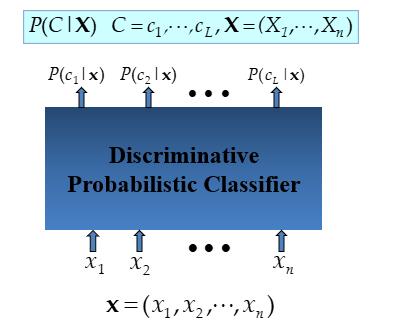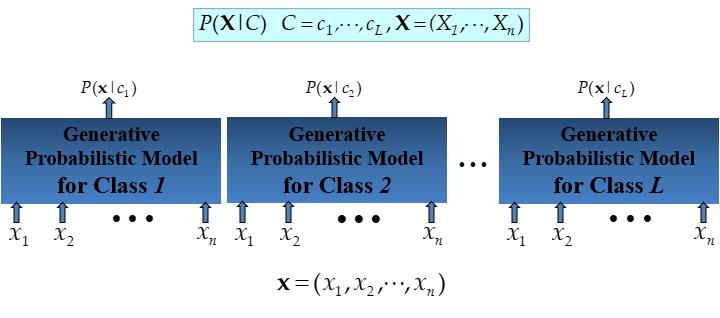 01.Naïve Bayes Classifier
01.Naïve Bayes Classifier
Background
There are three methods to establish a classifier
A. Model a classification rule directly
B. Model the probability of class memberships given input data
C. Make a probabilistic model of data within each class
Examples
| Method | discriminative classification | generative classification | probabilistic classification | Examples |
|---|---|---|---|---|
| A | Yes | No | No | k-NN, decision trees, perceptron, SVM |
| B | Yes | No | Yes | perceptron with the cross-entropy cost |
| C | No | Yes | Yes | naive Bayes, model based classifiers |
Probability Basics
Prior, conditional and joint probability for random variables
- Prior probability:
- Conditional probability:
- Joint probability:
- Relationship:
- Independence:
Bayes Rule (Bayesian Inference)
Basic Idea: We got a data
Quiz
We have two six-sided dice. When they are tolled, it could end up with the following occurance:
A. dice 1 lands on side "3"
B. dice 2 lands on side "1"
C. Two dice sum to eight
We set the probabilities:
a. dice 1:
b. dice 2:
c. dice 3:
Answer the following Questions:
- Is
Answer: Yes
Probabilistic Classification
Establishing a probabilistic model for classification
Discriminative model

Generative model

MAP classification rule
- MAP: Maximum A Posterior
- Assign
Generative classification with the MAP rule
- Apply Bayes rule to convert them into posterior probabilities
Naïve Bayes
- Bayes classification
Difficulty: learning the joint probability - Naïve Bayes classification
Assumption that all input features are conditionally independent!
MAP classification rule: for
- Algorithm: Discrete-Valued Features
- Learning Phase: Given a training set S,
For each target value of
for every feature value
Output: conditional probability tables; for - Test Phase: Given an unknown instance
Look up tables to assign the label
- Learning Phase: Given a training set S,
Examples: Discrete-Valued Features
Original Data
| Day | Outlook | Temperature | Humidity | Wind | PlayTennis |
|---|---|---|---|---|---|
| D1 | Sunny | Hot | High | Weak | No |
| D2 | Sunny | Hot | High | Strong | No |
| D3 | Overcast | Hot | High | Weak | Yes |
| D4 | Rain | Mild | High | Weak | Yes |
| D5 | Rain | Cool | Normal | Weak | Yes |
| D6 | Rain | Cool | Normal | Strong | No |
| D7 | Overcast | Cool | Normal | Strong | Yes |
| D8 | Sunny | Mild | High | Weak | No |
| D9 | Sunny | Cool | Normal | Weak | Yes |
| D10 | Rain | Mild | Normal | Weak | Yes |
| D11 | Sunny | Mild | Normal | Strong | Yes |
| D12 | Overcast | Mild | High | Strong | Yes |
| D13 | Overcast | Hot | Normal | Weak | Yes |
| D14 | Rain | Mild | High | Strong | No |
Learning Phase
| Outlook | Play = Yes | Play = No |
|---|---|---|
| Sunny | ||
| Overcast | ||
| Rain |
| Temperature | Play = Yes | Play = No |
|---|---|---|
| Hot | ||
| Mild | ||
| Cool |
| Outlook | Play = Yes | Play = No |
|---|---|---|
| High | ||
| Normal |
| Outlook | Play = Yes | Play = No |
|---|---|---|
| Strong | ||
| Weak |
Test Phase
Given a new instance, predict its label
Look up tables achieved in the learning phrase
Decision making with the MAP rule
Final Result
The fact
Algorithm: Continuous-valued Features
- Numberless values for a feature
- Conditional probability often modeled with the normal
- Learning Phase:
for
Output: - Test Phase: Given an unknown instance
- Instead of looking-up tables, calculate conditional probabilities with all the normal distributions achieved in the learning phrase
- Apply the MAP rule to make a decision
Example: Continuous-valued Features
Data
Temperature is naturally of continuous value.
Yes: 25.2, 19.3, 18.5, 21.7, 20.1, 24.3, 22.8, 23.1, 19.8
No: 27.3, 30.1, 17.4, 29.5, 15.1Estimate mean and variance for each class
According to the formula above, the result could be get
Learning Phase
output two Gaussian models for P(temp|C)
Relevant Issues
- Violation of Independence Assumption
- For many real world tasks,
- Nevertheless, naïve Bayes works surprisingly well anyway!
- For many real world tasks,
- Zero conditional probability Problem
- If no example contains the attribute value
- In this circumstance, $$ during test
- For a remedy, conditional probabilities estimated with
Summary
- Naïve Bayes: the conditional independence assumption
- Training is very easy and fast; just requiring considering each attribute in each class separately
- Test is straightforward; just looking up tables or calculating conditional probabilities with estimated distributions
- A popular generative model
- Performance competitive to most of state-of-the-art classifiers even in presence of violating independence assumption
- Many successful applications, e.g., spam mail filtering
- A good candidate of a base learner in ensemble learning
- Apart from classification, naïve Bayes can do more…
Explanation from Thuc
References
- Naive Bayes Classifier
Resource from Youtube
- Week 2 Slides from Thuc (SP52023)
